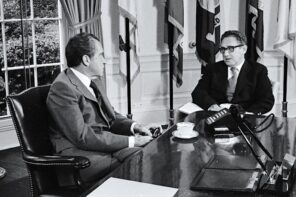The firsthand reports of mass killings and mass graves in Kadugli, Sudan, and the testimony of Anglican Bishop Andudu Adam Elnail remain at the center of a growing international controversy over the fate of the Nuban people, whom human rights groups, anti-genocide scholars, journalists, and Sudanese exiles say are the victims of a current and ongoing ethnic cleansing campaign by the Sudanese government that began on June 5.
One of the satellite images said to show a pile of white objects “consistent with” reports of body bags near the Episcopal Church complex in Kadugli (used by RD to illustrate our July 14 story on the dramatic report on mass killings and mass graves) is now a point of contention, and an indicator of how the United States has responded to the crisis.
That report, by the George Clooney-initiated Satellite Sentinel Project (SSP), received worldwide media attention while a New York Times piece, on an internal UN report compiled in June, confirmed many previously reported atrocities, adding:
In late June, a contractor working for the United Nations witnessed Sudanese Army soldiers filling a grave with bodies and covering it with a bulldozer. The Sudanese Army, paramilitary forces and government security forces have also attacked the United Nations force itself, the report said, including the summary execution of a Sudanese staff member.
The report, which was requested by the Security Council, recommends an independent investigation into human rights violations, including a possible referral to the International Criminal Court.
Amidst escalating calls for intervention, the UN Security Council met privately on July 15. Senior UN staff publicly called for UN and humanitarian access to the area and expressed concern about the reports of mass graves, extra-judicial killings, and attacks on UN personnel. The International Federation of the Red Cross and Red Crescent called for a joint IFRC and UN investigation of allegations (first reported by the Associated Press) that Sudanese intelligence agents disguised themselves as Red Crescent Society workers to lure refugees away from the UN compound to uncertain fates.
But just when it seemed that the world might be poised to intervene and to investigate the atrocities, the U.S. doused those hopes with a bucket of realpolitik cold water.
Special Envoy Princeton Lyman, who has downplayed the scope of the human rights abuses in Kadugli, told the Washington Post “what they identify as body bags, we see those same items in those same places before the fighting started.”
“We can’t confirm the conclusion in the Sentinel project that there are mass graves in Kadugli,” Lyman continued, citing U.S. intelligence reports. At the same time, he acknowledged that there “might” in fact be mass graves.
Eric Reeves, a scholar of genocide and a professor at Smith College was shocked by Lyman’s claim. “Even without the SSP report,” he told RD, “he must know that there are repeated [statements from] credible witnesses who say there are mass graves. My God, there is a witness, a UN contractor cited in the UN report.” (See section 34, where the report states: “She reported that SAF elements transported the bodies to the site, dumped them in the grave and using a bulldozer to cover the grave.” The area the witness identified, south of the Tilo school, is the same area where SSP’s witnesses also saw mass graves.)
“There are way too many facts that Lyman’s account does not take into account,” Reeves concluded. “It’s as if the UN report does not exist.”
Lyman’s skepticism is even more difficult to justify given that the satellite image taken on June 17 of a spot near the complex of buildings belonging to the Episcopal Church of Sudan showed no white items, while the white items are evident in the image of the same spot from July 4. SSP also told the Post that an additional satellite image shows no white objects in that spot on June 7.
The envoy’s claim that the piles of white “items” pictured in the satellite images were present prior to the fighting is unsubstantiated, and he offered no alternative explanation for what those white items might be or how they came to be in those spots.
Eyewitnesses cited by the SSP and the UN among others, state that house-to-house killings resulted in bodies being disposed of in white tarps or body bags throughout the city, then collected by the Sudanese Armed Forces in white trucks like urban trash collection here in the United States. Bishop Andudu told RD in an interview, for example, that a member of his congregation told him that he saw bodies wrapped in white body bags or some sort of white tarps at the grave site, then buried in two pits excavated by an earthmover on June 8.
Andudu added this plea: “The bishop says what is important is that many people have been killed and displaced. He needs the international community and the U.S. to protect the people of the Nuba Mountains by stopping the bombardment, to send effective international peacekeeping troops to monitor the situation, and to provide humanitarian aid for the needy people of Nuba Mountains.”
According to Reeves, Ambassador Lyman has a record of downplaying atrocities in Sudan, even while expressing “concern” about them, as he did in the Post. It is one element of what Reeves describes as a pattern of American governmental avoidance of serious action in response to the ethnic cleansing campaigns in the border provinces of Darfur, Abyei, and most recently, South Kordofan.
Lyman’s apparent effort to dampen mounting pressure for outside intervention in Kadugli, came shortly after calls by a coalition of human rights activists, Sudanese diaspora, and genocide scholars, for “limited” American military intervention “to destroy carefully selected military assets of the government of Sudan.”
In so doing, the coalition invoked the UN doctrine of “Responsibility to Protect” which is an outgrowth of world reflection on the lack of international response to the genocide in Rwanda during the 1990s. Now considered an established international “norm” (as distinct from a “law”), it’s based on the idea that all states are obliged to protect their citizens against atrocities; including genocide, war crimes, crimes against humanity, and ethnic cleansing. When a state is unable to protect its citizens or is responsible for the crimes, it is then the responsibility of the international community to intervene—including military intervention as a last resort. The authority for military intervention rests with the UN Security Council and the General Assembly.
The Obama administration and NATO were quick to invoke this doctrine when Libyan troops fired on civilians during the Arab Spring uprising—before siding with rebels in a campaign to topple the Qaddafi government.
In any case, the Associated Press reported on July 10 that UN Ambassador Susan Rice had already “dismissed the possibility of U.S. military intervention in South Kordofan… She noted that the U.S. has not been involved militarily in Sudan and she doesn’t foresee that changing in the near future.”
Reeves thinks the credibility of the Doctrine to Protect is on the line. “Darfur would seem to have sounded the death knell for any meaningful commitment to the ‘responsibility to protect,’” he wrote, “but South Kordofan offers one last opportunity. Real hope, however, seems entirely unwarranted.”
Reeves told RD that in addition to what he thinks are “thousands” killed directly in South Kordofan, there will be tens of thousands more who have fled to the Nuba Mountains who will also die of starvation unless Khartoum allows humanitarian aid in. The daily aerial bombings have caused farmers to flee leaving the fields untended. And if there is no planting, there will be no harvest in October. “There will be mass starvation,” he said. “A major catastrophe. Tens of thousands will die in the Nuba mountains. They will watch their children die before they die themselves.”
“If the world stands idly by this time,” Bishop Andudu told RD last month, “they will bring genocide.”




